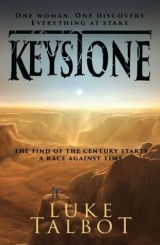
Текст книги "Keystone"
Автор книги: Luke Talbot
Жанры:
Триллеры
,сообщить о нарушении
Текущая страница: 14 (всего у книги 36 страниц)
It was only present on the book from the plinth. And it had never before been seen outside the Library.
She had spent a total of four weeks at the site, longer than she had initially planned, and had returned regularly ever since. In the ten years since the excavation, only a small fraction of the texts from the Library had even been looked at.
Because of the mystery surrounding the Amarna Stickman, she had decided to put it on the cover of her book. Her publisher had readily agreed. For an academic book, it had sold in surprising numbers, nothing short of a best-seller, and beyond her wildest expectations.
Chapter 35
The double-doors of the lecture theatre suddenly burst open. She jumped as she was torn from her reminiscing and three hundred students poured inside.
The noise was incredible. There was shouting, laughing, jeering, talking, banging of chair seats as they were flipped down, shuffling of feet, somebody tripping on the stairs and dropping their bag and a particularly deep laugh somewhere near the back which she could only describe as a ‘guffaw’.
After about five minutes, Gail looked at her watch and decided it was time to close the doors. As she returned to the podium, she could see students pointing to her slide and whispering comments to their neighbours. This lot are lively, she thought to herself with a smile as she prepared to start her lecture.
She dimmed the lights and checked attendance on the podium’s console: a better turnout than usual, there were three hundred and fifty-two people seated in the theatre; eighty-six more than the previous year.
Walking out from behind the podium – she briefly thought of the first lecture she had given, when she had literally hidden behind it – she introduced herself and welcomed them to the course, Introduction to Egyptology.
Looking around the room, she noted with a certain degree of pride that practically everyone was transfixed by either her or the projection on the wall behind. She had never seen such an eager group.
“Egyptology is the study of Egypt and its antiquities,” she began. “It has been practiced in its present form for over two hundred years, and is closely linked both to archaeology and history. How many of you here are taking Archaeology and History?”
Approximately half the theatre raised their hands. Some said yes, one person near the back said he wasn’t sure, to which everyone laughed.
“Until the turn of the twenty-first century,” she continued, “the last royal tomb to be excavated in Egypt was that of Tutankhamen, in 1922. For decades, many people believed that the last tomb in the Valley of the Kings had been discovered. They were very wrong. Since 2006, three more tombs have been discovered and excavated there, two in the last decade alone.” She looked around the theatre at her wide-eyed audience. I must be getting good at this, she thought to herself. “Over the past fifteen years, Egypt’s Supreme Council of Antiquities has seen major investment and modernisation; it now has the capability to regulate and oversee three times the number of simultaneous archaeological excavations compared to fifty years ago, particularly in the pharaonic sector. In other words, the Egyptian government, aided by UNESCO, has invested millions in making it easier to go to Egypt and do archaeology.” She paused and looked behind her at her introduction slide. “And believe me, if you thought two hundred years was enough to find out everything there is to know about Egypt, think again. Egypt is throwing up unexpected find after unexpected find, every day.”
She stopped talking and walked back to the podium. Hitting the screen once with her index finger, the slide changed to a photograph of the book that had been on the plinth in the Library at Amarna, with the Stickman carved into its cover.
“Has anyone seen this Stickman symbol before?” she asked confidently. She always liked to follow this up with ‘don’t worry, until about ten years ago, neither had anyone else’.
Except that this time, not one hand stayed down.
She was used to the normal group, usually near the front, who would raise their hands, sometimes smugly. But since she had started giving the same lecture two years earlier, nothing had come close to this. She was amazed, and was about to say ‘Wow!’, when Professor David Hunt burst through the door at the back of the lecture theatre.
He stumbled down the steps, mumbling apologies to the students, most of whom still had their hands held high. He didn’t even say hello to Gail as he rushed over to the podium and closed her presentation. Bringing up an Internet browser, he found the BBC website and expanded the ‘Breaking News’ of the day.
“Look!” he said, out of breath, pointing up at the projection on the wall.
Gail turned round, still in shock. She read the words, her eyes widening.
‘Evidence of Intelligent Life Revealed on Mars,’ the headline claimed, boldly.
“Wow!” she finally said, as if her brain had queued the word she had been about to say before David’s entrance, and had to make her say it before more words could be used.
“No,” David said with a grin like a Cheshire cat. “This is wow!” He scrolled down to the bottom of the page, and clicked on a picture. She saw two people in space suits standing on some sort of platform on the side of a cliff. He clicked to show the next picture: a close up of the platform, which she now saw was like a small stone jetty coming out of the cliff wall. He clicked to show the last picture. It was another close up of the stone, clearly showing the engraving on its surface.
“Is this some kind of joke?” she said, walking towards the screen. She was oblivious to the excited talking going on in the theatre behind her. “Is that really Mars?”
“Yes!” he almost shouted.
Gail needed to sit down. She pulled a stool out from under the podium and perched herself on top of it. “How?”
“I have no idea, but I’m going to love finding out,” he replied. He was even more enthusiastic than usual, like a small child at a birthday party after too many sweets. “You’ve got to agree with some of my ideas now, Gail, haven’t you? You might even have to revisit some of your Amarna dating,” he jabbed.
She was absolutely stunned. “I don’t know,” was all she could say. “I don’t know.”
That the news showed proof of extra-terrestrial life was amazing.
That it had been intelligent extra-terrestrial life was barely credible.
But that such intelligent life had managed to carve the very same Amarna Stickman, in all of its glory, into the surface of a rock a hundred million miles away on Mars left Dr Gail Turner utterly speechless.
Chapter 36
Larue’s English was certainly good enough to get the general idea of the book Martín had given him, and he had now read enough of it to know what to do next. Nevertheless, he continued to flick through it with increasing interest, dwelling on a series of photos of the archaeological excavation. In one shot, an attractive young lady and a much older, bearded man stood proudly beside a large rectangular stone in the desert. Another picture showed a row of bookshelves covered in scrolls and clay tablets of varying sizes. The picture he was most interested in, however, was of a large engraving on a wall showing the symbol from Mars next to a bunch of hieroglyphs.
He called Martín back in to his office, and when the Spaniard entered he snapped the book shut. He opened his desk drawer and took out a large wallet. “So, you’ve met Dr Turner before?”
Martín smiled proudly and nodded. “Yes, in London. I was visiting some friends and we went to one of her lectures.”
“Why?” Larue was intrigued as to why a young man with a master’s degree in physics would be interested in archaeology.
“A friend of mine was studying history, and recommended that we all go to the lecture with him, because we were doing nothing else that afternoon.” He looked at the signed copy of the book. “He was also too shy to ask her to sign his copy of the book, so I did it for him. I got confused and she signed it for me instead. My friend was quite upset and told me to keep the book.”
Larue smiled at his little story.
“Martin, I think that this cover-up is not over. I don’t believe for a second that whoever is behind it will simply turn over and admit defeat. We will be accused of the same fakery as we are accusing them of.”
He opened his drawer and withdrew a credit card. He placed it on the desk in front of him. “This book is very interesting, but from what I can see it doesn’t make any reference to Mars. And yet here we are. Dr Gail Turner will no doubt have made progress in her research in the last few years. Maybe she knows something she wasn’t able to publish at the time. While we are unable to get close to the findings on Mars, we should look to this site in Egypt to help explain what is going on.
“Your encounter with her, no matter how brief, does give you an icebreaker of sorts, and she may help us find out more. I want you to find her and get more information.” He pulled a piece of paper from the drawer and, along with the credit card, pushed it across the desk. “This is the pin number for the business card, which you may use as required.”
“But Monsieur, I am not a detective!” he complained.
“You are a researcher in my department. This is your research.” Larue closed the drawer and gestured for him to leave.
As the door closed behind him, Martín looked down at the handful of items he was carrying. His assignment was certainly outside the normal remit of the ESA, he thought to himself, shaking his head. But although he was initially apprehensive, he quickly realised he’d just been given a golden opportunity to satisfy his own curiosity, as well as that of his boss.
He strode to his desk and opened up a browser window on his laptop, and started tracking Dr Gail Turner down.
Chapter 37
Seth Mallus shut the door and took his seat opposite Dr Patterson at the imposing desk. Bright sunlight poured through the window of the meeting room. Outside, an old man cycled past whistling and in the distance a group of children could be seen playing with a football on the sandy beach. Palm trees swayed gently as seagulls drifted on the warm breeze.
Dr Patterson was looking out of the window with interest.
“It’s amazing what can be achieved with modern technology, Doctor,” Mallus told him. “When my father was a boy, the most impressive computers could barely play chess. Now, in simulator windows like this they can make us think that we are enjoying a summer’s day in California, while in the distance, sitting at a small table, two men who don’t even exist are themselves playing chess to the level of the Grandmasters.”
One of the boys playing football on the beach was arguing with the others. He was holding the football close to his chest, and shouting at the top of his voice. Dr Patterson could not make out what he was saying, but the outcome was clear. Three of the other boys suddenly jumped on him, trying to wrestle the ball away from his grip. Within a minute, they had seized it and were triumphantly marching off to their friends, where they quickly resumed their game. The first boy picked himself up from the sand, nursing his jaw. Blood was dripping from his nose. He stole a glance at the other boys as he retreated to the promenade by the beach. The three dimensional effect was staggering, to the extent that had he not been assured it was a computer simulation the thought would never have crossed his mind.
“Man will never change, Dr Patterson. Our playground simply gets larger, the footballs more expensive, and the games more deadly.” He swung his chair round to look at the scientist. “The strong and powerful continue to make the rules, and there is one absolute certainty: the longer you play, the more likely you are to get hurt.”
Patterson wasn’t sure what Mallus was alluding to, but his threatening tone was making him nervous. “I see,” he lied.
Mallus leant forward and pointed to the scientist’s folder, which he had placed on the desk in front of him. “Tell, me; since we last saw each other, has anything enlightening sprung to mind?” he asked.
“I’ve made some progress, but nothing noteworthy. I was very surprised when -”
“You turned the news on this morning?” Mallus finished the sentence for him.
“I didn’t expect them to find it so soon. And I certainly didn’t expect to see it on TV.”
Mallus looked at him closely then shook his head. “The leaks to the press have caused us to accelerate our project somewhat, but there is still too much that we do not understand regarding Aniquilus, too much that you have not been able to tell us, despite your best attempts. This is why, if all goes well, Dr Gail Turner will be joining you tomorrow to start helping.”
Patterson looked at him in disbelief. That he was assigned some help from one of the other research teams was one thing, but Dr Gail Turner...
“She can read the text, from what the reports say, largely without the aid of a translating device like you, Doctor. And you know everything about Mars and a great deal about Aniquilus. Of all the people in the list you provided me with, I believe the two of you will make the best pairing.”
There was a shout from the virtual world outside the window, barely audible through the ‘glass’, and Patterson looked up to see the same fight over the football happening all over again. Following his gaze, Mallus shook his head and snapped a command at the screen, which promptly changed to a sprawling cityscape; Mallus’ office had gone from a beach to the topmost floor of a virtual skyscraper.
After a short pause to take the view in, Mallus looked at him intently. “Something has to be done to stop it, Doctor. The book is the key, I’m certain of that. I’m also certain that we don’t have much time left.”
Chapter 38
Gail’s phone had not stopped ringing all morning. She had cancelled her remaining lectures and seminars for the day and returned to her office with David Hunt to look at the Mars findings in more detail. Despite speaking to dozens of people, her mobile still had over thirty missed calls, and her desk phone had more voicemails than she dared count.
She held her head in her hands and exhaled loudly.
“Gail, I know this may be hard, but you may have to accept that Amarna and Mars are linked,” David said apologetically.
Looking up at him, she scowled before burying her face again. “Easy for you to say,” she mumbled. “You’re used to people trying to discredit you! This is Egyptology; I’ll be hung out to dry!”
Professor David Hunt knew exactly what she meant. Over the years, dozens of weird and wonderful theories had been put forward regarding the pyramids, the Sphinx, and the pharaohs; all of those theories had been ridiculed by Egyptologists. Often, they would simply not bother trying to disprove the theory, but would dismiss it out of hand. Gail was worried about keeping her career intact and away from disrepute.
“Look at the bigger picture, Gail: they’ve found evidence of intelligent life on Mars!” he said. “And those creatures used the same symbol as your Amarna people. You couldn’t have gone to Mars to plant evidence any more than you could have carved the Stickman into all those shelves in Amarna, so they can’t possible claim that you made any of this up, can they?”
“That’s not the point!” she whined. “The Egyptian authorities are renowned for refusing to authorise archaeological excavations if they believe an unfavourable alternative theory is being developed. They famously stalled excavation of irregularities in Khufu’s pyramid because Japanese and French researchers couldn’t satisfy their demands that it would significantly advance science. The second I openly admit to a link between Mars and Amarna, I can kiss my access to the Amarna Library goodbye, and there are still over three thousand books that we haven’t even opened yet!”
“Not this time: this is science, Gail! You can see as well as I can that those symbols are identical. There is only one possible reason for that isn’t there?”
Gail sat holding her head for several minutes as David waited patiently for an answer. She looked up. “There is another possible explanation.”
He looked her in the eyes and his face fell. “Gail, don’t do this!” he pleaded with her.
“But you have to admit it’s possible, don’t you? That the Mars photos are faked is a hell of a lot more likely than the alternative, don’t you think? Why do you so readily believe that they are genuine?”
“The truth is that regardless of where those images came from, regardless of how authentic they may be you simply don’t want to accept that there may be some inherent link between the two sites,” he told her, firmly. “You’re grappling for a conspiracy theory that disproves the relationship between the two, instead of objectively looking at all the evidence and judging it on its own merits.” His eyes met hers and softened. “The reason I can still work here, despite all my years trying to prove my unpopular theories, is because I have never forgotten that archaeology is a science, and that scientific method is the foundation of everything that we do.
“I know that there is a twenty-three thousand year old village on the edge of the Caspian Sea because of scientific evidence, not because that’s what I wanted to be true. Had it been only four thousand years-old, it would still have been an important find. As it is, it helped fuel my career for the past fifteen years. Look for the evidence to support a link between Amarna and Mars, and you may be surprised. There may be something in the texts that you have already seen that may now make more sense.”
“I am absolutely sure that there is nothing in the texts I have looked at that suggests a link. There is no evidence I know of in the archaeology in Amarna, or even in the rest of Egypt – the rest of the world! – that can point to a link with extra-terrestrials.” She was angry now, her eyes filled with emotion. Her entire career had been based on the Amarna Library, but the photos from Mars had her looking at a bleak future. “I have two choices,” she said as calmly as possible. “Either I support the possibility of E.T., or I refute it completely.”
David looked at her and smiled. “You made your choice years ago, Gail, when you accepted your scroll from the Dean. You have to be a scientist.”
“There’s always a choice to be made. But first, I have to speak to Professor al-Misri.”
As if on cue, the desk phone started ringing.
Gail was tempted to let it ring: the sheer volume of calls that morning had left her weary of lecturers, friends, family and even students, all asking her the same questions. But then she recognised the Cairo telephone number on the display.
“Mamdouh, I was just about to call you, how strange!”
David pushed himself up from the armchair in which he had been lounged and gestured to Gail that he was popping into his own office for a while.
Gail nodded and continued speaking to the Professor. “Yes, I saw the news. How couldn’t I? I’m fairly certain it’s faked, or that –”
He had just reached the door when Gail stopped mid-sentence. Something about the lengthy pause in her telephone conversation made him prolong his stay in her office for a few moments.
“But, how do you know?” she said, the words stumbling out.
David backed away from the door and regained his seat, all the time studying her face for any signs of what the Egyptian could be saying to her on the other end of the line.
Suddenly, she was saying her goodbyes and hanging up. She sat in silence for over a minute, looking into space, before David could bear it no longer.
“Well?” he urged. “Doesn’t he think that the photos are faked?”
She looked at him, and shook her head slowly. “No.”
“Why not?”
“Because he has seen proof that suggests otherwise.”
“What kind of proof?”
“He can’t tell me over the phone. I have to see him in Cairo tonight. He’s already booked my flight.”
There was something about her pale face and expression, telling him that there was more to it than that. “What’s wrong, Gail?” he asked softly.
She looked him in the eyes. “He says that there’s another book from the Amarna Library, one that I’ve never seen.”
David sighed. “There’s more than just one, Gail! There are more than three thousand books in the Library that you’ve not yet had the time to study, and you know more than anyone about that place.”
Now she was frantically clicking through folders of images on her computer screen, some that had been used in her book, many thousands more that had not. She finally reached the folder she was looking for.
A rendition of the Backscatter X-ray, from a few days before they had entered the Library for the first time, filled the screen. She zoomed in on the plinth, on which the Stickman book had been found.
She flicked through a pile of papers on her desk and brought out an A3 print of another photo, this one taken from inside the Library, behind the plinth. The Stickman book covered less than half of the plinth’s surface.
Comparing the two images, her jaw dropped.
“How did I not notice this before?” she wondered.
“Unbelievable,” he whispered.
“My entire career, all my studies, my lectures, my thesis, everything! It’s all been based on corrupted evidence!” she wailed.
He looked at her wide-eyed as she broke down in front of him. He was horrified and upset for his colleague. But deep-down inside, part of him thrust a clenched fist in the air and cried victory. All his life he had searched for proof of archaeological and historical cover-ups, and now it looked like he would finally get what he’d been looking for.
For on close inspection, the Backscatter X-ray showed the Stickman book, and right next to it, with barely a gap between, was a second identically-sized tome. The photo from inside the Library, however, showed only one, lonesome book.
Not only had there been a cover-up, but it had happened right in front of her eyes.








